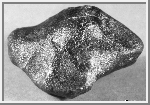 Educator's Guide to Micrometeorites
Educator's Guide to Micrometeorites
Courtesy of the Jet Propulsion Laboratory
Collecting Micrometeorites
Shooting stars are not, of course, really stars. They are
actually small bits of rock and metal that collide with Earth's
upper atmosphere and, because of friction, burn up. On rare
occasions, man-made satellites and spacecraft parts fall into the
atmosphere and burn up the same way.
The flash of light from this incineration is correctly called a
meteor. A meteor is formed when an object, usually the size of a
marble or a piece of popcorn, hits the atmosphere at an altitude
of 80 to 100 kilometers (50 to 62 miles).
The air at that height is very thin but
the objects are moving at tens of thousands of kilometers per
hour. To get an idea of what friction does, place your hands
together and rub them back and forth. Now rub faster. What is
happening? That is what is happening to the particles in the
upper atmosphere.
Larger objects do not burn up completely. Surviving fragments
fall through the atmosphere and land on Earth. Once one of these
objects lands it is called a meteorite. Most meteorites fall
into Earth's oceans.
Meteorites can be either rock, metal (nickel and iron) or a
mixture of both. Stony meteorites are difficult to identify.
They
do not glow or give off radioactivity. Stones outnumber
metals.
But metallic meteorites are easier to find. Rarely are chunks of
metal found lying about. A metal detector can be used to search
for metallic meteorites. Dry barren areas where there is little
vegetation to cover up the ground and turn over the soil are the
best. Dry lake beds are good places to search
because wind can
blow dust off of the surface,
leaving the meteorites exposed.
Many meteorites are found on the Antarctic ice sheet.
There is an easy way to collect meteorites, but we must be
satisfied with finding small metal ones. They are actually
microscopic and are known as micrometeorites. Tons of these fall
on Earth each day.
To collect micrometeorites you need to find a place where they
can become concentrated. The drains of a house or building work
well since rainwater can wash particles off of an entire roof and
collect them at the drain spout. Tile roofs are best since they
drain very well and do not produce many other sorts of particles
or debris.
But dust, plants, pieces of window screens and all other sorts of
airborne material also collect there. To find the metallic
micrometeorites, collect and dry some of the material from a deep
bowl at the base of the drain spout. After removing leaves and
other debris, place the remaining material on a piece of paper
and place a magnet under the paper. Tilt and tap the paper so
that all of the non-metallic particles fall off.
Many of the remaining metallic particles are pieces of space
dust! To examine them, place the paper under a microscope. High
power will be required to see them clearly. Most of the
particles are not from space,
but the micrometeorites will show
signs of their fiery trip through the atmosphere. They will be
rounded and may have small pits on their surfaces.
Much of what you are observing are particles that date from the
formation of the solar system around 4.6 billion years ago! They
are the debris remaining from the raw materials that formed into
the nine known planets and the asteroids. Most particles have
been broken off or ground down from larger objects.
| 














